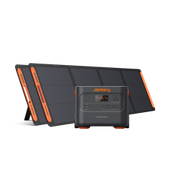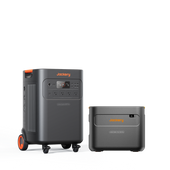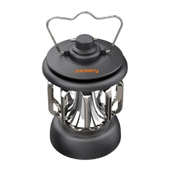An off-grid generator is a power system that can charge appliances during power outages, camping, fishing, and RVing. It's an ideal charging solution that can completely eliminate your reliance on utility grids. While there are different types of off-grid generators available, solar-powered generators are preferable because of their eco-friendly nature.
Jackery Solar Generators are reliable off-grid and solar-powered generators that can charge up to 99% of household appliances during power outages or when living entirely off the grid. They also feature double wheels and foldable handles, ensuring easy movement when enjoying outdoor adventures in remote locations. They are whisper-quiet and can be used in living spaces or RV campgrounds with noise restrictions.
Key Takeaways
- An off-grid generator is a charging solution that can charge appliances and eliminate reliance on the utility grid.
- Different types of off-grid generators include solar, gas, diesel, and inverter generators.
- When choosing an off-grid generator for your power needs, consider power output, capacity, portability, and durability.
- The size of the solar generator you need will depend on the off-grid appliances you wish to charge simultaneously and for how long.
What Is an Off-Grid Generator
Off-grid living is a sustainable practice that involves eliminating reliance on the utility grid. An off-grid generator is a solar power system that works independently from the utility grid and stores energy in batteries to provide power when needed. It is commonly used to power off-grid homes or to offer backup power to homes in the event of a power outage or blackout.
The Benefits of an Off-Grid Generator
An off-grid generator works independently from the utility grid, which ultimately reduces the high electricity bills. Installing an off-grid solar generator ensures you don't have to worry about power outages or blackouts. If you are still unsure if an off-grid generator is worth the investment, here are some of the benefits to check out:
Reduce Carbon Footprint: Off-grid living with solar generators is more eco-friendly than on-grid and fossil fuel generators. The off-grid generator does not work on fossil fuels such as gas or coal, which reduces the overall carbon footprint.
Low Energy Costs: If you are planning to completely eliminate the high electricity bills, an off-grid solar generator sounds like a reliable choice. It works by harnessing free solar energy and generating electricity, thereby reducing energy costs.
Energy Independence: Off-grid generators offer you energy independence, allowing you to live anywhere without being dependent on the local electrical company. In addition, you won't have to worry about the power outages happening in the community.

Clean Energy: Solar generators help you utilize the power of the sun, a renewable and never-ending source that's clean and eco-friendly. Choosing off-grid solar generators not only reduces the reliance on fossil fuels but also makes a positive impact on the planet.
Types Of Off-Grid Generators
Off-grid generators offer uninterrupted power supply during power outages, camping, or RV living. There are different types of off-grid generators that vary depending on the fuel used. Some generators, like gasoline, are installed outside the home, whereas solar generators can be used in the interior space.

Here, we have compiled a list of different types of off-grid generators available based on their fuel type:
Gasoline Generator
A gasoline generator operates using a gasoline-fueled combustion engine to convert gasoline to electricity. It can provide temporary power during outages, construction sites, outdoor events, and recreational activities. However, you should avoid using gasoline generators indoors or in an enclosed space. This is because gasoline generators emit toxic fumes, which can be dangerous when inhaled.
Pros
- Wheels attached to gasoline generators make them portable
- Cost-effective than other generators
- Fuel is readily available
Cons
- Shorter lifespan than other generator types
- Not suitable for heavy-duty appliances
- Rely on gasoline availability
Solar Generator
Solar generators are easy-to-use, portable charging solutions for indoor and outdoor use. They are lightweight and compact enough to be transported easily, making them ideal for outdoor adventures such as camping, overlanding, and RV living.
Many large solar generators feature double wheels and handles to move them anywhere you like. They combine solar panels that convert the sunlight into DC electricity and portable power stations to store the AC electricity and charge appliances, such as ACs, lights, fans, freezers, refrigerators, etc.
Pros
- Renewable and eco-friendly energy source
- Low operating and maintenance costs
- Reduces the reliance on utility grids
- Offers reliable power during power outages
Cons
- Weather-dependent
- High initial setup costs
- Limited power supply
Diesel Generator
A diesel generator is a backup generator type featuring a diesel engine. It works by converting mechanical into electrical energy to charge household or outdoor appliances. Diesel generators provide backup power during outages and are best known for their high output. They're typically available from a few kilowatts to several megawatts. Diesel generators are suited for backup power in areas that are prone to power outages or where a consistent supply is needed.
Pros
- High power output
- Longer lifespan
- Efficient fuel consumption
Cons
- Emits a lot of toxins
- Not suitable for indoor uses
- High initial costs
- Need regular maintenance
Inverter Generator
An inverter generator produces clean and stable electricity by converting AC to DC and then back to AC to ensure a consistent power output. It is ideal for charging sensitive electronics and off-grid appliances, such as smartphones, laptops, and medical equipment. While they commonly run on gasoline, there are some models that use either propane or natural gas. They are mostly used for tailgating, camping, and situations where a stable power supply is essential.
Pros
- Clean and stable power output
- Ideal for sensitive electronics
- Compact and lightweight
- Quieter and fuel-efficient
Cons
- Higher initial cost
- Slightly complex maintenance
- Limited power for heavy-duty appliances
How Much Electricity Do You Need For Off-Grid Living
If you are using essential appliances such as LED lights, a phone charger, a small refrigerator, and a phone charger, you'll likely need nearly 1000 - 1500 watts. A small family who wants to live comfortably with a small refrigerator, some fans, and moderate electronic usage needs 3000 - 5000 watts of electricity. Larger homes with high loads like air conditioning, electric water heaters, and dishwashers need around 8000 watts of electricity.
The first step to living off the grid is understanding the electricity load or how much electricity you use. Electricity consumption is typically expressed in kilowatt-hours (kWh) and can be easily estimated by the appliance's wattage. The average American household sometimes uses around 30kWh per day. However, the exact wattage consumption will depend on the starting and running wattages of the off-grid appliances.
Here's the list of off-grid living appliances you might use at home:
|
Off-Grid Appliances |
Starting Wattage |
Running Wattage |
|
Refrigerator |
1200W |
400W |
|
LED Light |
/ |
10W |
|
Kettle |
/ |
1000W |
|
Induction Cooktop |
/ |
1100W |
|
Portable AC |
1400W |
700W |
|
AC |
2000W |
1000W |
|
TV |
/ |
150W |
|
Laptop |
/ |
100W |
|
Electric Grill |
/ |
1600W |
When calculating the electricity needed for off-grid living, you'll need to simultaneously add the running wattages of the appliances you plan to use. For example, if you are using a refrigerator (400W), a portable AC (700W), and an induction cooker (1100W) simultaneously, you'll need a generator that has a rated output of at least 2200 - 2500W.
One important thing to note is that motorized appliances require some starting wattage, which the generator needs to supply for efficient charging. You need to check the highest starting wattage of the appliances that need to be charged simultaneously and add the number to the total running wattage. The obtained number will act as the surge peak output of the off-grid generator.
Here's the mathematical formula:
Total Surge Peak of Generator = Total Running Wattage of Appliances + Highest Starting Wattage of One Appliance
In the above example, both refrigerator and portable AC have a starting wattage of around 1200W and 1400W, respectively. Since portable AC has the highest starting wattage, you will need to add the total running wattage and highest starting wattage to get the surge peak output of the generator. In this case, the surge peak output will be equal to 2200W + 1400W = 3600W.
Jackery Solar Generators are reliable and portable solar-powered generators that can supply electricity to 99% of off-grid appliances such as refrigerators, ACs, lights, etc. They are lightweight and feature compact designs that make them easy to move. The generator is suitable for indoor or outdoor use as it does not emit any toxic fumes or noise.
Best 3 Off-Grid Solar Generators
Off-grid solar generators are eco-friendly, reliable, and portable charging solutions for indoor and outdoor power needs. Jackery is a well-known manufacturer of high-quality off-grid solar generators, solar panels, and battery power stations. The Jackery Solar Generators combine highly efficient portable power stations and foldable solar panels to charge off-grid appliances.
The Jackery Solar Generator works when sunlight hits the foldable solar panels, converting the sun's energy into DC electricity. The portable power station's pure sine wave inverter then converts DC to AC electricity to charge appliances. Depending on your power needs, here are the three best off-grid generators.
Jackery Solar Generator 2000 Plus
If you are living in a small apartment and need to charge only basic appliances at the same time, you may go ahead with the Jackery Solar Generator 2000 Plus. It has a large battery capacity that can charge up to 99% of household appliances during the event of a long-term power outage or blackout. It also features a pull rod, foldable handle, and double wheels to move the generator to camping locations or RV campgrounds.
Appliances Running Time
- Air Conditioner (1000W) = 1.7H
- Refrigerator (400W) = 4.3H
- LED Lights (10W) = 173.6H
- Induction Cooktop (1100W) = 1.5H
- TV (150W) = 11.5H
- Water Heater (1000W) = 1.7H

Customer Review
Very good quality batteries last a very long time. Very easy to move around with the built-in tires. Love the upgradeability. The best solar generator I have ever had." — Marc.
Jackery Solar Generator 2000 Plus Kit (4kWh)
The Jackery Solar Generator 2000 Plus Kit (4kWh) is the expanded version that can charge up to 99% of household or outdoor appliances. It can power heavy-duty appliances, such as ACs, power tools, etc., for long hours to ultimately reduce the reliance on the utility grid. The off-grid generator works by using free sunlight, so you don't have to pay high electricity bills or find power outlets in remote locations.
Appliances Running Time
- Air Conditioner (1000W) = 3.4H
- Refrigerator (400W) = 8.6H
- LED Lights (10W) = 347.2H
- Induction Cooktop (1100W) = 3.1H
- TV (150W) = 23.1H
- Water Heater (1000W) = 3.4H

Customer Review
"The Jackery Explorer 2000 Plus and Battery Pack with the 400W solar panels package is a great combination for home backup and RV usage. I like the idea that if I need more power, I can purchase another battery pack. The wheels on the generator are great as 64 lbs is easier to pull/push instead of carrying it." — Larry Gee.
Jackery Solar Generator 2000 Plus Kit (6kWh)
If you live in an area prone to long-term power outages or wish to reduce your reliance on the utility grid, you may consider choosing the Jackery Solar Generator 2000 Plus Kit (6kWh). Its large capacity makes the solar-powered generator ideal for indoor and outdoor purposes. The best part about the off-grid generator is that it emits only 30dB of noise, which is whisper-quiet.
Appliances Running Time
- Air Conditioner (1000W) = 5.2H
- Refrigerator (400W) = 13.0H
- LED Lights (10W) = 520.9H
- Induction Cooktop (1100W) = 4.7H
- TV (150W) = 34.7H
- Water Heater (1000W) = 5.2H

Customer Review
"This is absolutely a great addition to the 2000 Plus. I mainly have this for power outages, but I will use it on the occasional camping trip. I will probably buy an additional pack to make my supply 6k." — Mark Watkins.
How to Choose The Best Off-Grid Generator
When selecting off-grid generators, you must consider many factors, such as power output, capacity, portability, etc.
Power Output and Capacity
First, you need to check the power output and capacity of the off-grid generator. You should start by calculating the total wattage of the appliances that you would run simultaneously. When selecting the off-grid generator, check if the peak and continuous output can meet the power needs.
Portability
If you're planning outdoor adventures like camping or RV living with an off-grid generator, you need to check its portability. Look for a generator with wheels and handles for added flexibility and portability.
Fuel Type
When choosing the off-grid generator, you need to look for the fuel type. For example, gasoline generators are widely available and suitable for outdoor needs. Gasoline generators have a long lifespan and are more efficient but tend to be expensive.
Solar generators are eco-friendly charging solutions that can charge most indoor or outdoor appliances compared to other fuel types. They depend on sunlight and do not emit any toxic fumes, making them ideal for indoors.
Noise Level
The noise level of the off-grid generator is an important consideration, especially if you will be using it indoors or in a quiet environment. It's recommended that the dB (decibel) rating of the off-grid generator be checked. Jackery Solar Generators typically operate by emitting 30dB of noise, which is less than that of a whisper.
Durability and Build Quality
Lastly, you should look at the durability and build quality of the off-grid generator. You should always choose a generator built with robust materials that can withstand harsh conditions.
How to Build An Off-Grid Generator
Building your own off-grid generator is a multi-step process. Here is the list of parts and components you'll need:
- Solar panels are the most essential element of the off-grid solar system, as they absorb sunlight and generate electricity.
- A solar battery backup is required to store the excess electricity generated by the solar power panels.
- The inverter converts the DC electricity produced by the solar panels to alternating current to charge household or outdoor appliances.
- The solar charge controller prevents the voltage and current levels from overloading the battery. It regulates the voltage coming from the solar panels.
- The battery maintainer is an additional small charger that supplies bursts of power to the battery and keeps the main battery active.
Now that you know the components required, here’s how to build an off-grid generator:
Step 1: Purchase the Solar Panels and Battery
Your first step is to calculate your energy needs and accordingly purchase solar panels and a battery. The solar panels you choose should be built with monocrystalline silicon solar cells that have high conversion efficiency. There are two main battery types available: Lithium-ion and LiFePO4. They are highly efficient and have a longer lifespan compared to lead-acid batteries.
Step 2: Complete the Installation and Wiring
You will need a DC input to transmit the DC from the solar panels to the power system. Sometimes, you'll also need an inverter to convert the DC to AC. You can set everything in position and connect the wires. To get started, connect the negative poles first and then connect the DC inlet to the battery.
Step 3: Test the Parts
Your off-grid generator system is ready to use. Before you start charging the appliances, make sure to test each part and ensure it works appropriately.
Off Grid Generator FAQs
What size generator do I need for off-grid living?
The right size of solar generator for off-grid living will depend on the total wattage consumption of the appliances you want to run at the same time and the operating hours. For instance, if you wish to charge an air conditioner (1000W), LED lights (10W), and TV (150W) at the same time, the running time of the Jackery Solar Generator 3000 Pro can be calculated using the below formula:
Working Hours = Battery Capacity in Wh × 0.85 / Operating Wattage of the Appliances = 3024Wh × 0.85 / 1160W = 2.2H
Note: We have multiplied the battery capacity by 0.85 because charging the appliances will cause some power loss.
What is the best off-grid power generation?
Solar generators are one of the best off-grid power generation methods because they work using free solar energy. It typically comprises solar panels and a battery storage system to generate electricity and keep appliances charged for hours.
How many kW do I need for off-grid living?
On average, an off-grid home usually needs around 7kW (or 7000W) of electricity. However, the exact needs might depend on the wattage of the appliances you are using and for how long.
What voltage is best for off-grid?
12V power works great for a majority of off-grid electrical systems.
How much battery storage do I need to go off-grid?
Nearly 8 - 12 solar batteries are required to live off the grid, and the storage capacity will depend on how much energy you need daily.
Final Thoughts
Going off the grid means disconnecting access from the utility power grid. An off-grid generator is a reliable charging solution that can power most household or outdoor appliances for long hours. The right size of an off-grid solar generator will depend on the wattage consumption of the appliances you plan to use simultaneously.
Jackery Solar Generators come in different sizes. They are reliable and eco-friendly solar-powered generators that charge 99% of household appliances during a power outage. They are portable in nature and can be carried on camping, RV, and overlanding trips.
Are you planning to live off the grid and eliminate reliance on the utility grid? If so, do you want help deciding on a solar generator size? Let us know in the comments below!








































![[Add - on] Jackery Manual Transfer Switch for Explorer 5000 Plus - Jackery](http://www.jackery.com/cdn/shop/files/add-on-jackery-manual-transfer-switch-for-explorer-5000-plus-9017324.png?v=1754016782&width=170)





























































































Thank you for your amazing generators, the explanations provided and guidance.
Leave a comment